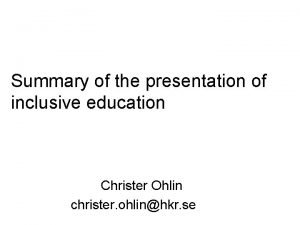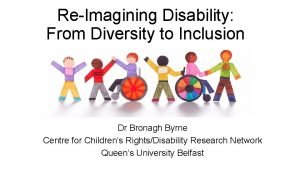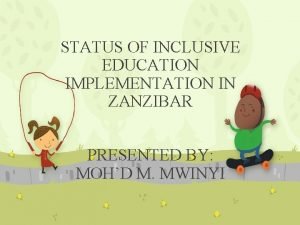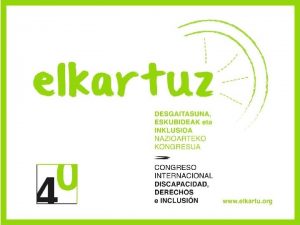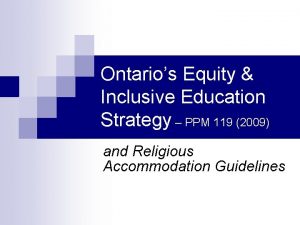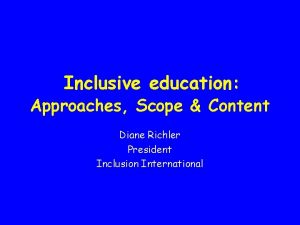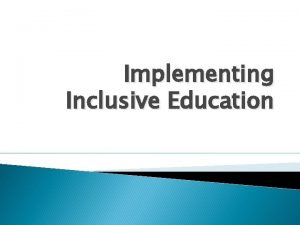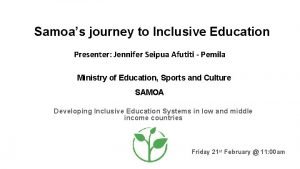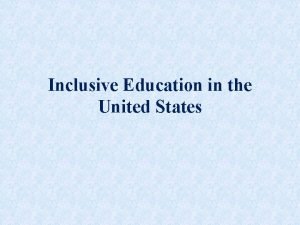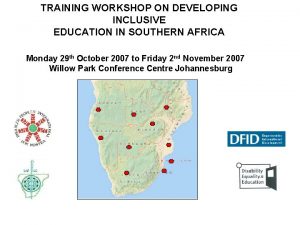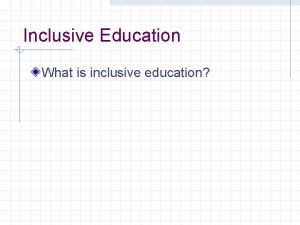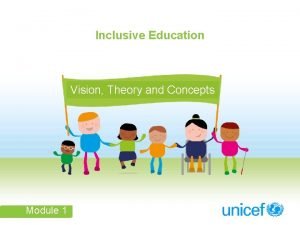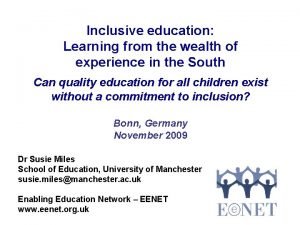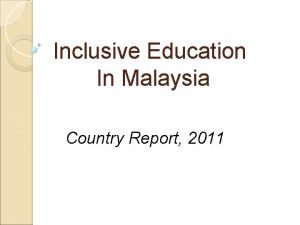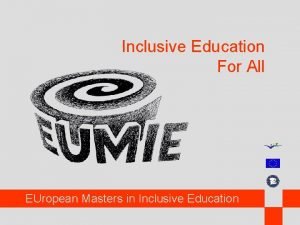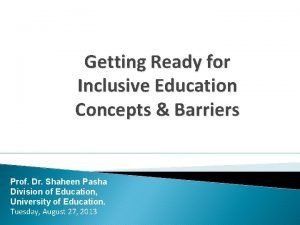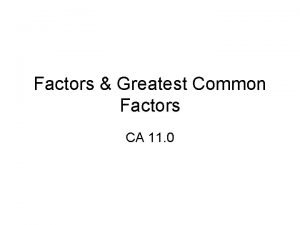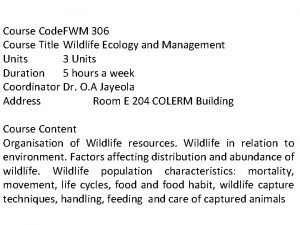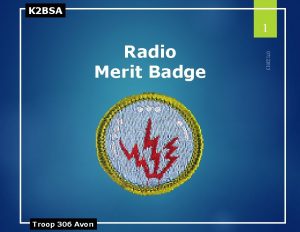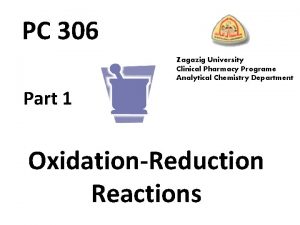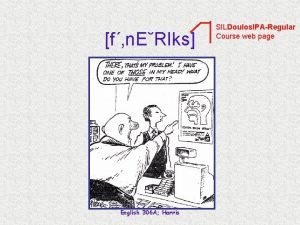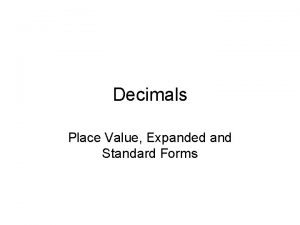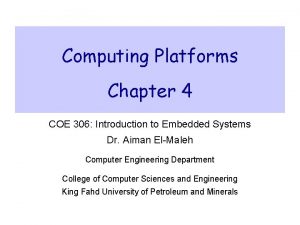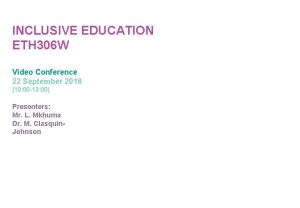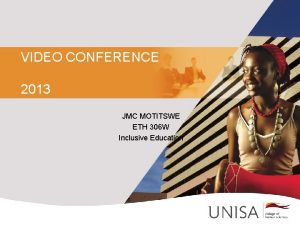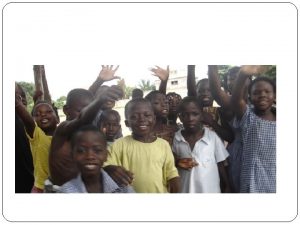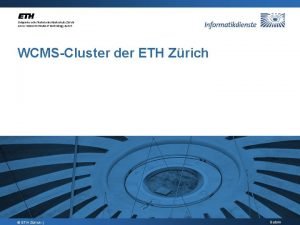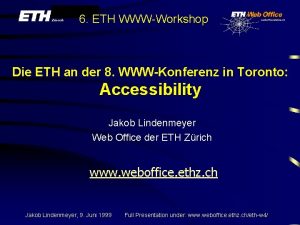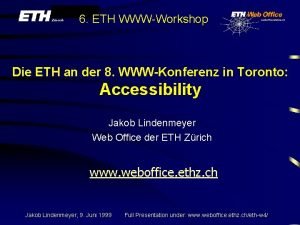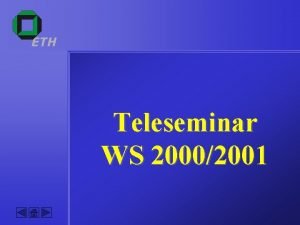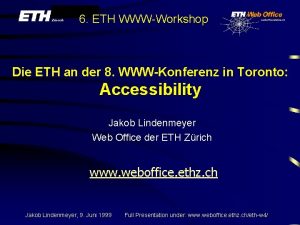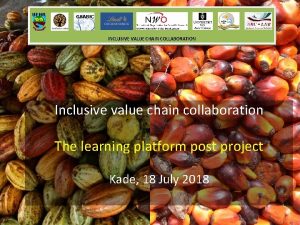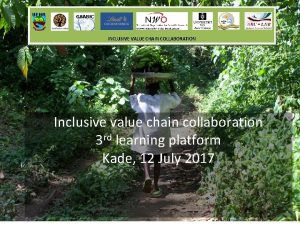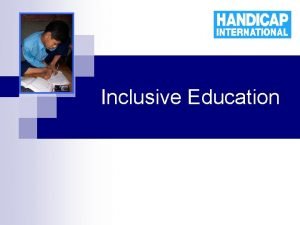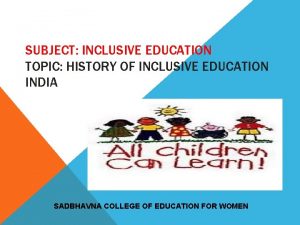INCLUSIVE EDUCATION ETH 306 W Video Conference 21
































- Slides: 32

INCLUSIVE EDUCATION ETH 306 W Video Conference 21 July 2017 (12: 00 -14: 00) Presenters: Dr. M. Clasquin-Johnson Ms. K. Malahlela

INTRODUCTION 1. Who are your lecturers and what kind of support can you expect from them 2. Communication: Please contact us by email, phone, engage in discussion forum, book personal visits, read my. Unisa notices – refer to tutorial letter 101 page 5 3. Assignment matters – due dates/extensions, role of lecturers, language, neatness, NB keep a copy 4. Examination matters – admission, preparation (previous question papers at own risk), conduct (during exam) , release of results, aegrotat and FI Concessions

ETHW 306 W Inclusive Education Definition of inclusion Inclusion is about increasing the participation√ of learners in and reducing their exclusion from the cultures, curricula, and communities of local schools. It involves restructuring the cultures, policies and practices√ in schools so that they respond to the diversity√ of learners. It is concerned with the learning and participation of all learners√ vulnerable to exclusionary pressures, not only those with impairments√ or those categorised as experiencing barriers to learning and development√. READ WP 6: Appendix N (p. 319)

MAINSTREAMING OR INCLUSION? Mainstream or Integration Inclusion Mainstreaming is about getting learners Inclusion is about recognising and to ‘fit into’ a particular kind of system or respecting the differences among all learners and building on the similarities. integrating them into this existing system. Inclusion is about supporting all learners, educators and the system as a Mainstreaming is about giving some learners extra support so that they can whole so that the full range of learning ‘fit in’ or be integrated into the ‘normal’ needs can be met. classroom routine. Learners are assessed by specialists who diagnose and prescribe technical interventions, such as the placement of learners in programmes. The focus is on teaching and learning actors, with the emphasis on the development of good teaching strategies that will be of benefit to all learners.

Mainstream or Integration Inclusion Mainstreaming and integration focus on changes that need to take place in learners so that they can ‘fit in’. Inclusion focuses on overcoming barriers in the system that prevent it from meeting the full range of learning needs. Here the focus is on the learner. The focus is on the adaptation of and support systems available in the class- room.

BARRIERS TO LEARNING AND DEVELOPMENT What are barriers to learning? INTERNAL/INTRINSIC BARRIERS TO LEARNING - Factors inherent in learners themselves. - Learners were born with these or acquired them later - Factors not related to education or environment. - Include physical, physiological or mental impairments. - Note: degrees (severity) of impairments - Note causes: genetic factors, prenatal/perinatal/postnatal brain damage (epilepsy, cerebral palsy, learning impairments such as dyslexia (difficulty with reading) or dyscalculia (difficulty with arithmetic), intellectual impairment, hearing impairment, visual impairment) = specialised support required

EXTERNAL/EXTRINSIC BARRIERS TO LEARNING At home, at school and in the community (differentiate) External to the learner - Socio-economic barriers - Discriminating attitudes - Inflexible curriculum - Language and communication - Inaccessible and unsafe environment - Inapplicable or inadequate provision of support services - A lack of empowering and protective policy - Disability - A lack of human resources development Discuss each in detail. Refer to your study guide pages 1920.

PARENTS’ REACTION TO THEIR CHILDREN’S BARRIERS (IMPAIRMENTS) - Grief - Guilt - Anxiety - Resentment - Denial - Anger - Overprotection - Rejection - Compensation - Feeling rejected as parents Discuss these reactions. Provide examples.

EXAMPLES OF SUPPORT TO LEARNERS Support starts with identification Hearing Impairments: Characteristics - Often misinterprets instructions - Turns head to listen - Watches the teacher’s lips - Cannot understand the teacher if the teacher’s head is turned away or the teacher’s lips are covered - Finds it difficult to locate the source of a sound - Speaks too loudly or too softly - Speaks monotonously

Support for Hearing Impairments Use an overhead projector to present material. Assign a peer to take notes using carbon paper. The peer can also check that the learner is following in the correct place when the class is working on a task. Speak clearly in a normal voice and at a moderate pace (speed). Use visual signals to gain the learner’s attention. Ask questions to check learners’ understanding of orally presented content or directions. Rephrase content or questions to make it more understandable.

VISUAL IMPAIRMENTS Characteristics Loss of or restricted vision influences the language, motor and socioemotional development of the learner Itching, burning or scratchy feeling in the eyes Inability to see well Dizziness, headaches, or nausea, following close work Blurred or double vision Inability to see in bright light

Support for Visual Barriers The type of eye condition will determine the assistance required. Learners with myopia and cataracts should sit in-front, near the chalkboard. Repeat (verbally) what is written on the chalkboard. Use a magnifying glass if large print books are not available. Use a koki pen to draw parallel lines on paper. Printed material should be clear, attractive and meaningful. Common errors: Do not discuss cataracts, etc. !

Support for Physical Impairments Give the learners tasks and responsibilities-with due regard to physical abilities. Arrange the furniture in the playroom in such a way that the cerebral palsied learners can move about freely. Also make sure that the washbasin and the toilet are easily accessible. Store apparatus and positions activities in places where the learners will be able to reach them. Organise floor and table games which the cerebral palsied learners can manage and which will encourage participation. It is always advisable to build up learners’ self -esteem. Physically disabled learners feel different from other people. If the learners have difficulty with their handwriting, you could try to provide a typewriter, arrange an oral examination for the learner.

EPILEPTIC SEIZURE - SUPPORT Be alert! Look out for warning signs. Record all incidents of seizures. Remain calm. Prevent the learner from falling. Push furniture out of the way. Do not hold the learner or try to prevent movement! Ensure that the airway is clear. Turn the learner onto his/her side to prevent choking on excessive saliva. Loosen tight clothing, especially around neck and waist. Seek medical assistance if seizure is protracted, or if learner chokes, or if learner sustains any injuries.

BEHAVIOURAL PROBLEMS AS A BARRIER Identification Antisocial behaviour Taking others’ property Aggression Bossiness Egocentricity Destructiveness Antagonism towards members of the opposite sex Social aggression Negatively influence learner’s development and learning NB: Always focus your discussion on your specialization phase.

BEHAVIOUR MODIFICATION TECHNIQUES - Reinforcement - Ignoring Time-out / Withdrawal (special circumstances, with circumspection and warn the learner beforehand) Self-chosen time-out / withdrawal Prevention Redirection Discussion / conversation (find a workable solution) Special time (spend time alone with the learner) Study guide pages 230 -255

DOWN SYNDROME Motor skills’ challenges are common. Poor manipulation due to: - Hypotonia (low muscle tone) in arms and hands - Shorter limbs and digits - Reduced stamina Implications of motor skills’ challenges are that: Handwriting may be oversized or undersized and light/sketchy Manual skills such as cutting, using concrete materials and equipment may be less accurate and completed more slowly.

AUTISM or Autistic Spectrum Disorder (ASD) High complex, unique behaviours may include: Limited eye contact Unusual development of cognitive skills; for example, poor learning skills or resistance to normal teaching methods Language (speech) delay, and communication difficulties Social interaction may be limited Unusual responses to sensory inputs, such as covering the ears Sense of touch, taste, sight, hearing and/or smell may be heightened or diminished Unusual eating patterns High pain threshold

AUTISM or Autistic Spectrum Disorder (ASD) Crying or laughing for no apparent reason Self-injurious behaviour such as head banging, scratching and biting Abnormal sleep patterns The development of speech and language may be abnormal, delayed or absent. A person shows minimal reaction to verbal input and appears to act as though deaf. The repetition of words, questions, phrases and/or sentences over and over again (echolalia) Endless monologues about their special interests without adapting to the needs of the listener Words and phrases may be used incorrectly. The production of speech may be unusual, e. g. a flat and monotonous tone.

KEY COMPETENCIES IN CLASS • • • Language Speaking Reading Writing Mathematics NB: All learners can learn and all learners need support

LANGUAGE AS A BARRIER TO LEARNING 1. Manifestations of language problems 2. Possible causes of language barriers 3. Support strategies

WRITING AS A BARRIER NOTE: Foundation and Intermediate phases Consider essay, spelling and handwriting as main components of writing Focus on underlying causes, manifestations (how can we see) and support For example: some learners may experience problems with essay writing due to cognitive problems which result in disordered thinking and they cannot write a coherent essay. Essay writing is a part of writing in all the phases (p. 275) § The learners sit in the classroom (note repetition) Manifestations: These learners write simple, short, repetitive and disordered sentences. Support: focus on mastering the basic concepts and build further from them

BARRIERS RELATED TO READING – APPENDIX L By the end of this section, you should be able to: § § § Define the concept ‘reading’ Define the components of reading Discuss factors which may cause reading difficulties Discuss manifestations of reading difficulties Discuss strategies which can be used to support learners with reading difficulties

BARRIERS RELATED TO READING- cont. • Decoding • and Reading comprehension as components of reading Underlying causes of difficulties § Learning disabled – due to neurological impairments such as dyslexia § Unwilling learners § Underachievers § Slow learners**** learners with limited intellectual abilities but this term is not acceptable anymore in Inclusive Education

READING - MANIFESTATIONS • • Poor sight vocabulary Reading slowly and inaccurately Poor reading comprehension Poor self concept and low motivation to read etc. NB: Proceed to the next pages in your study guide related to reading problems per phase and language level e. g. home language / first additional

BARRIERS RELATED TO READING - SUPPORT Consider the following: Planning Choice of material Consider the following Check guidelines Reading coding and comprehension

BARRIERS RELATED TO MATHEMATICS At the end of this section, you should be able to: § § § Define the concept ‘mathematics’ and its branches Define mathematical readiness Factors that may lead to problems in mathematics Manifestations Support/Aid to learners experiencing difficulties in mathematics NB: Read the whole section and focus more on learners in your phase

FACTORS THAT MAY LEAD TO DIFFICULTIES NOTE: These factors may combine with a number of other factors such as general learning difficulties to cause difficulties in learning. § Inadequate instruction by the teacher – check school related factors § Aimless focus on drill work § Negative attitudes towards mathematics § Reading difficulties may impact on mathematics

MANIFESTATIONS Foundation Phase § 4+3 = 7, 6 – 4 = 10, 2 x 5 = 7 Intermediate § Unable to read numbers greater than 100 § Cannot understand long multiplication and division § Struggle with capacity, money etc. – 1 litre in a big cup, in a flay plastic container and in a bottle

Intervention and Support General considerations such as adequate planning, attitudes, motivation, early identification etc. Specific considerations: § Explain the concepts clearly § Use concrete teaching aids § Show the physical closeness of numbers when teaching rounding off § Align the learners’ real work with mathematical problems

EMOTIONAL DIFFICULTIES • It applies to learners at all levels but affect them differently • Unmet emotional needs – read early signs/manifestations • Look for strategies to support these learners especially teenagers

LECTURERS’ CONTACTS Mr. Lindokuhle Mkhuma Tel: 012484 1121 E-mail: mkhumi@unisa. ac. za Address: UNISA Sunnyside Campus, Building No. 10, Office 0 -91, Pretoria 0003 Ms. Kate Malahlela Tel: 0124812755 Email: malahmk@unisa. ac. za Address: UNISA Sunnyside Campus, Building No. 10, Office 0 -096, Pretoria 0003 Dr. Mary Clasquin-Johnson Tel: 0124812863 E-mail: clasqmg@unisa. ac. za Address: UNISA Sunnyside Campus, Building No. 10, Office 0 -61, Pretoria 0003
 Conclusion of npe 1986
Conclusion of npe 1986 Reimigining disability and inclusive education
Reimigining disability and inclusive education Achievement of inclusive education in zanzibar
Achievement of inclusive education in zanzibar Reimigining disability and inclusive education
Reimigining disability and inclusive education Ontario's equity and inclusive education strategy
Ontario's equity and inclusive education strategy Scope of inclusive education
Scope of inclusive education Unesco inclusive education
Unesco inclusive education Inclusive education policy
Inclusive education policy What is this photo
What is this photo Inclusive education and community partnership
Inclusive education and community partnership Objectives of inclusive education
Objectives of inclusive education Npe 1986 conclusion
Npe 1986 conclusion Aims and objectives of inclusive education
Aims and objectives of inclusive education Objectives of inclusive education
Objectives of inclusive education Inclusive education definition
Inclusive education definition Disadvantages of inclusive education slideshare
Disadvantages of inclusive education slideshare Jämförlighet
Jämförlighet Acrostic poem about policy
Acrostic poem about policy Barriers to inclusive education
Barriers to inclusive education Allied core value rbp
Allied core value rbp Hcf of 30
Hcf of 30 Ecologist
Ecologist Om306
Om306 Troop 306
Troop 306 Ed 306
Ed 306 Las virtudes teologales cuales son
Las virtudes teologales cuales son Calomel electrode
Calomel electrode Paulo cesar sentelhas
Paulo cesar sentelhas Meteorologia cesar
Meteorologia cesar Meteorologia cesar
Meteorologia cesar 306
306 306 in expanded form
306 in expanded form Examples of dual devices
Examples of dual devices
